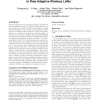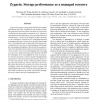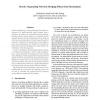45 search results - page 6 / 9 » Scheduling Real-Time Data Items In Multiple Channels And Mul... |
MOBICOM
2004
ACM
14 years 26 days ago
2004
ACM
Recent years have seen the growing popularity of multi-rate wireless network devices (e.g., 802.11a cards) that can exploit variations in channel conditions and improve overall ne...
INFOCOM
2007
IEEE
14 years 1 months ago
2007
IEEE
— Multicast is an efficient means of transmitting the same content to multiple receivers while minimizing network resource usage. Applications that can benefit from multicast s...
ICC
2007
IEEE
14 years 1 months ago
2007
IEEE
We consider a single-cell multiple-input multiple-output (MIMO) downlink channel where linear transmission and reception strategy is employed. The base station (BS) transmitter is...
RTAS
2006
IEEE
14 years 1 months ago
2006
IEEE
Large-scale storage systems often hold data for multiple applications and users. A problem in such systems is isolating applications and users from each other to prevent their wor...
MOBISYS
2005
ACM
14 years 7 months ago
2005
ACM
Inverse multiplexing, or network striping, allows the construction of a high-bandwidth virtual channel from a collection of multiple low-bandwidth network channels. Striping syste...



